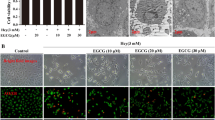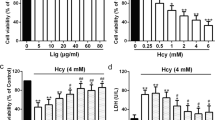Abstract
Hyperhomocysteinemia is a risk factor for cardiovascular disease and the mechanism of homocysteine (HCY)-induced vascular endothelial cell injury has been intensively studied for many years. Recently, a large number of studies have shown inhibitory effects of genistein (GEN), a soy isoflavone, in the process of endothelial cell injury. In the present study, the protective effects of GEN in HCY-induced endothelial cell inflammatory injury were investigated. A model of HCY-induced endothelial cell (ECV-304) inflammatory injury was established in vitro, and the protective effect of GEN in this procession was explored. According to our results, GEN protected HCY-induced endothelial cell from viability decreases, meanwhile prevented the changes of cell morphology and the production of reactive oxygen species (ROS). The expression of NF-kB P-65, IL-6, and ICAM-1 was all down-regulated. During the HCY-induced endothelial cell injury, the endothelial cell apoptosis and proliferation disorder were alleviated. Therefore, we conclude that HCY-induced endothelial cell inflammatory injury could be blocked by GEN. The present findings suggest that GEN protects HCY-induced endothelial cell inflammatory injury may through reducing the release of ROS, inhibiting NF-kB activation, down-regulating the expression of cytokine IL-6 and adhesion molecules ICAM-1, avoiding inflammatory cells and platelet adhesion, accordingly, leading to a balance of endothelial cell proliferation and apoptosis.




Similar content being viewed by others
References
Chen F, Castranova V, Li Z et al (2003) Inhibitor of nuclear factor kappaB kinase deficiency enhances oxidative stress and prolongs c-Jun NH2-terminal kinase activation induced by arsenic. Cancer Res 63:7689–7693
Yang G, Abate A, George AG et al (2004) Maturational differences in lung NF-κB activation and their role in tolerance to hyperoxia. Clin Invest 114:669–678
Lemarie A, Morzadec C, Delphine M et al (2006) Arsenic trioxide induces apoptosis of human monocytes during macrophagic differentiation through nuclear factor-kB related survival pathway down-regulation. J Pharmacol Exp Ther 316:304–314
Ross R (1999) Atherosclerosis-an inflammatory disease. N Engl J Med 340:115–126
Pearson TA, Mensah GA, Alexander RW et al (2003) Markers of inflammation and cardiovascular disease: application to clinical and public health practice: a statement for healthcare professionals from the Centers for Disease Control and Prevention and the American Heart Association. Circulation 107:499–511
McCully KS (1969) Vascular pathology of homocysteinemia: implications for the pathogenesis of arteriosclerosis. Am J Pathol 56:111–128
Boushey CJ, Beresford SA, Omenn GS, Motulsky AG (1995) A quantitative assessment of plasma homocysteine as a risk factor for vascular disease. Probable benefts of increasing folic acid intakes. JAMA 274:1049–1057
Nygard O, Vollset SE, Refsum H et al (1995) Total plasma homocysteine and cardiovascular risk profile. The Hordaland HCY Study. JAMA 274:1526–1533
Ueland PM, Refsum H, Beresford SA, Vollset SE (2000) The controversy over homocysteine and cardiovascular risk. Am J Clin Nutr 72:324–332
Tehlivets O (2011) Homocysteine as a risk factor for atherosclerosis: is its conversion to s-adenosyl-L-homocysteine the key to deregulated lipid metabolism? J Lipids 2011:702853
Dong D, Wang B, Yin W et al (2013) Disturbance of copper homeostasis is a mechanism for homocysteine-induced vascular endothelial cell injury. PLoS One 8:e76209
Clarke M, Bennett M, Littlewood T (2007) Cell death in the cardiovascular system. Heart 93:659–664
Thompson SG, Kienast J, Pyke SD, Haverkate F, van de Loo JC (1995) Hemostatic factors and the risk of myocardial infarction or sudden death in patients with angina pectoris. European concerted action on thrombosis and disabilities angina pectoris study group. N Engl J Med 332:635–641
Danesh J, Wheeler JG, Hirschfield GM et al (2004) C-reactive protein and other circulating markers of inflammation in the prediction of coronary heart disease. N Engl J Med 350:1387–1397
Ridker PM, Hennekens CH, Buring JE, Rifai N (2000) C-reactive protein and other markers of inflammation in the prediction of cardiovascular disease in women. N Engl J Med 342:836–843
Potenza MA, Gagliardi S, Nacci C, Carratu MR, Montagnani M (2009) Endothelial dysfunction in diabetes: from mechanisms to therapeutic targets. Curr Med Chem 16:94–112
Srinivasan S, Bolick DT, Hatley ME et al (2004) Glucose regulates interleukin- 8 production in aortic endothelial cells through activation of the p38 mitogen-activated protein kinase pathway in diabetes. J Biol Chem 279:31930–31936
Morigi M, Angioletti S, Imberti B et al (1998) Leukocyte-endothelial interaction is augmented by high glucose concentrations and hyperglycemia in a NF-kB-dependent fashion. J Clin Invest 101:1905–1915
Srinivasan S, Yeh M, Danziger EC et al (2003) Glucose regulates monocyte adhesion through endothelial production of interleukin-8. Circ Res 92:371–377
Exner M, Hermann M, Hofbauer R et al (2001) Genistein prevents the glucose autoxidation mediated atherogenic modification of low density lipoprotein. Free Radic Res 34:101–112
Fotsis T, Pepper M, Adlercreutz H et al (1993) Genistein, a dietary-derived inhibitor of in vitro angiogenesis. Proc Natl Acad Sci USA 90:2690–2694
Kiriakidis S, Högemeier O, Starcke S et al (2005) Novel tempeh (fermented soya bean) isoflavones inhibit in vivo angiogenesis in the chicken chorioallantoic membrane assay. Br J Nutr 93:317–323
Kayisli UA et al (2013) Genistein inhibits cell proliferation and stimulates apoptosis in human coronary artery endothelial cells. Gynecol Obstet Invest 75:235–242
Babu PV, Si H, Fu Z, Zhen W, Liu D (2012) Genistein prevents hyperglycemia-induced monocyte adhesion to human aortic endothelial cells through preservation of the cAMP signaling pathway and ameliorates vascular inflammation in obese diabetic mice. J Nutr 142:724–730
Homeister JW, Willis (2010) Atherosclerosis: pathogenesis, genetics and experimental models. Encyclopedia of life sciences. John Wiley, Sons Ltd, Chichester
Hofmann MA, Lalla E, Lu Y et al (2001) Hyperhomocysteinemia enhances vascular inflammation and accelerates atherosclerosis in a murine mode. Clin Invest 107:675–683
Plazar N, Jurdana M (2012) Hyperhomocysteinemia: relation to cardiovascular disease and venous thromboembolism. In: Abdelaal MA (ed) Pathophysiology and clinical aspects of venous thromboembolism in neonates, renal disease and cancer patients. InTech, Rijeka, pp 17–34
Edirimanne VE, Woo CW, Siow YL et al (2007) Homocysteine stimulates NADPH oxidase-mediated superoxide production leading to endothelial dysfunctionin rats. Can J Physiol Pharmacol 85:1236–1247
Weiss N (2005) Mechanisms of increased vascular oxidant stress in hyperhomocysteinemia and its impact on endothelial function. Curr Drug Metab 6:27–36
Cortes Magdalena P, Juan P (2013) Inhibition of ATP-induced calcium influx by homocysteine in human umbilical vein endothelial cells. Cell Biol Int 37:600–607
Tyagi N, Sedoris KC, Steed M et al (2005) Mechanisms of homocysteine-induced oxidative stress. Am J Physiol Heart Circ Physiol 289:H2649–H2656
Zhang T, Wang F, Xu HX et al (2012) Activation of nuclear factor erythroid 2-related factor 2 and PPARg plays a role in the genistein-mediated attenuation of oxidative stress-induced endothelial cell injury. Br J Nutr 2:1–13
El-Rayes BF, Ali S, Ali IF, Philip PA, Abbruzzese J, Sarkar FH (2006) Potentiation of the effect of erlotinib by genistein in pancreatic cancer: the role of Akt and nuclear factor-kappaB. Cancer Res 66:10553–10559
Li Y, Sarkar FH (2002) Inhibition of nuclear factor kappaB activation in PC3 cells by genistein is mediated via Akt signaling pathway. Clin Cancer Res 8:2369–2377
Manach C, Williamson G, Morand C, Scalbert A (2005) Re´me´sy C. Bioavailability and bioefficacy of polyphenols in humans. I. Review of 97 bioavailability studies. Am J Clin Nutr 81:230S–242S
Williamson G, Manach C (2005) Bioavailability and bioefficacy of polyphenols in humans. II. Review of 93 intervention studies. Am J Clin Nutr 81:243S–255S
Banerjee S, Li Y, Wang Z, Sarkar FH (2008) Multi-targeted therapy of cancer by genistein. Cancer Lett 269:226–242
Polkowski K, Mazurek AP (2000) Biological properties of genistein. A review of in vitro and in vivo data. Acta Pol Pharm 57:135–155
King RA, Bursill DB (1998) Plasma and urinary kinetics of the isoflavones daidzein and genistein after a single soy meal in humans. Am J Clin Nutr 67:867–872
Cassidy A, Faughnan M (2000) Phyto-oestrogens through the life cycle. Proc Nutr Soc 59:489–496
Jia Z, Babu PV, Si H et al (2013) Genistein inhibits TNF-α-induced endothelial inflammation through the protein kinase pathway A and improves vascular inflammation in C57BL/6 mice. Int J Cardiol 168:2637–2645
Fuchs D, Erhard P, Rimbach G et al (2005) Genistein blocks homocysteine-induced alterations in the proteome of human endothelial cells. Proteomics 5:2808–2818
Author information
Authors and Affiliations
Corresponding author
Rights and permissions
About this article
Cite this article
Han, S., Wu, H., Li, W. et al. Protective effects of genistein in homocysteine-induced endothelial cell inflammatory injury. Mol Cell Biochem 403, 43–49 (2015). https://doi.org/10.1007/s11010-015-2335-0
Received:
Accepted:
Published:
Issue Date:
DOI: https://doi.org/10.1007/s11010-015-2335-0




